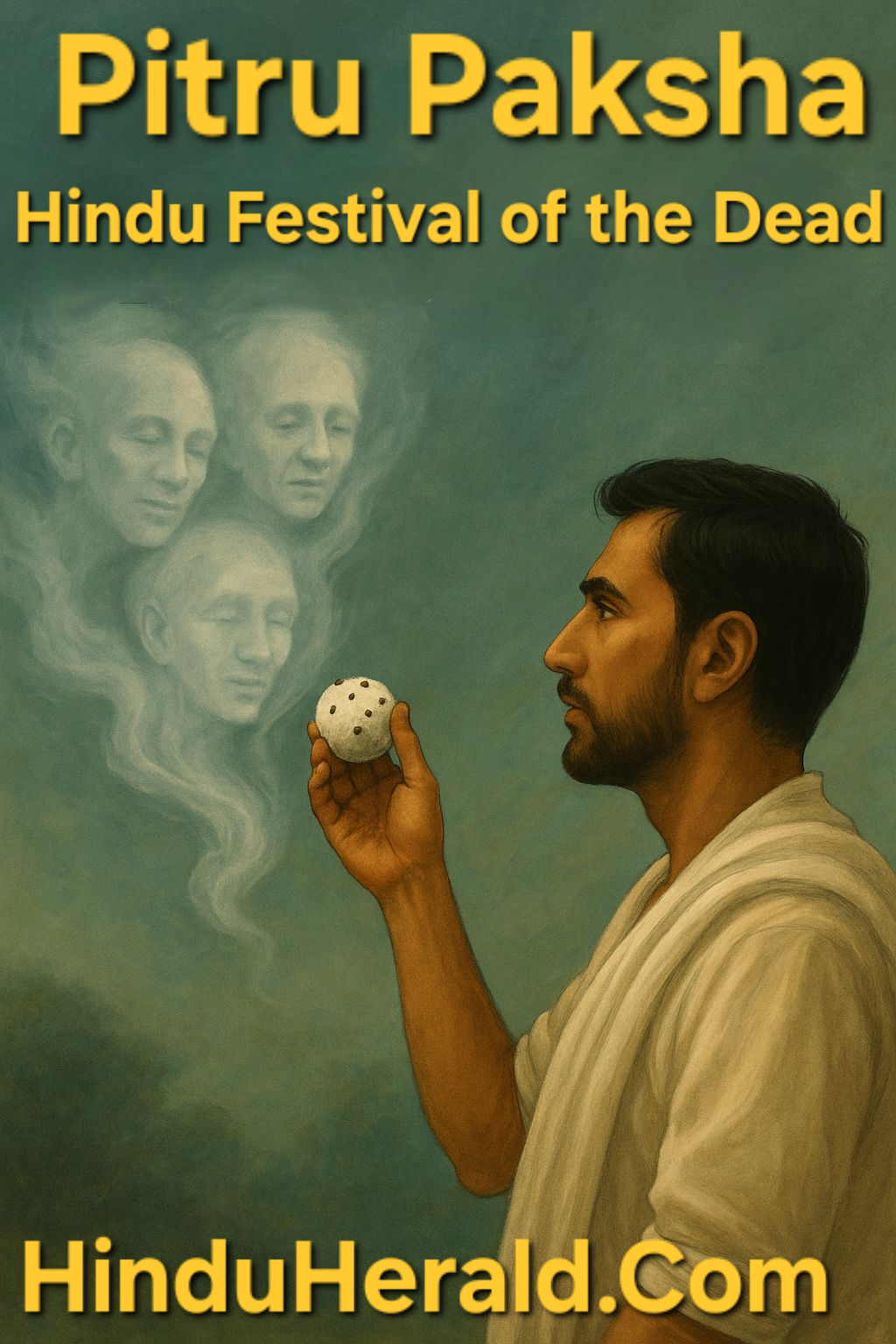
Pitru Paksha, Unfiltered: The Secrets Priests Never Tell You
By Hindu Herald Staff
The Shocking Secrets No One Tells You
Pitru Paksha is a two week Hindu festival where families offer their ancestors pinda rice balls and tarpana water offerings. This helps the ancestors in the afterlife. In return, ancestors send their blessings. But there’s a hidden side to these rituals that most people never hear about… until now!
Here’s what no mainstream festival write-up will ever tell you: During Pitru Paksha, your home becomes a spiritual border crossing.
When the offerings are made, ancestors literally descend into the body of a priest to accept the food! If you don’t have a priest and perform the rites yourself, those ancestors will come into your house — into the tarpana water and pinda rice balls you set out. If you perform Pitru Paksha rituals at home, your ancestors won’t be in some far off section of the spiritual world remotely receiving your offerings – their spirits will be right there in your house with you!
- They won’t behave exactly like you remember them. Their consciousness in Pitru Loka is different — symbolic, urgent, and not always gentle.
- Other spirits, not even related to you, might show up if boundaries aren’t strict.
- When you throw the water and pinda outside, the ritual isn’t over — your ancestors may briefly inhabit a crow, dog, or cow to complete the offering physically.
Most people think of Pitru Paksha as a simple “gratitude ritual.” The truth is far more intense — and knowing these mechanics is the only way to do it safely.
Two Kinds of Ancestor Rituals — And Why People Confuse Them
Not all shraddha is the same. Priests rarely explain this difference clearly.
1) First-Year Shraddha – Building a Soul’s Subtle Body
When someone dies, their soul is in a vulnerable, transitional state called preta.
- During this year, the family performs a series of rituals: 3rd day, 9th day, monthly rites, and the one-year mark.
- These offerings literally construct the soul’s subtle body (sukshma sharira), piece by piece.
The Garuda Purana describes this in unflinching detail:
Without these rites, the soul wanders naked, hungry, and lost — unable to move on to Yama’s court.
This stage is about helping the dead cross over safely.
2) Pitru Paksha – For Ancestors Already in Pitru Loka
Once the soul reaches Yama’s realm and judgment is complete, it goes to Pitru Loka, the ancestral plane.
- Pitru Paksha rituals are for 3 generations on your mother’s side and 3 generations on your father’s side. So your maternal and paternal lineage
Here, offerings serve a very different purpose:
- They aren’t for survival — your ancestors already have stable forms.
- They’re gifts of energy, gratitude, and connection, like sending a care package to loved ones who live far away.
First-year shraddha = survival and crossing over.
Pitru Paksha = gifts, remembrance, and family harmony.
Mixing these two up leads to misunderstandings — and sometimes dangerous rituals.
What Tarpana and Pinda Really Are
Priests will tell you “give rice balls and water.” They won’t tell you what those offerings actually become.
- Tarpana (water mixed with sesame seeds):
- Represents prana, the life force.
- Refreshes and uplifts ancestors spiritually.
- Flows like a message between realms.
- Pinda (rice balls with ghee or honey):
- Acts as a temporary body for your ancestor to inhabit for just a moment.
- Allows them to experience the offering directly before returning to Pitru Loka.
Think of tarpana and pinda as spiritual energy packets. The mantras “activate” them, the way a phone charger sends invisible current. Without mantra, it’s just rice and water. With mantra, it’s a bridge between worlds.
The Mind of the Ancestor: Not What You Remember
We like to think of Grandma in heaven smiling sweetly at us, just like she did in life. But when a soul is in Pitru Loka, its consciousness changes dramatically:
- Time and thought don’t work like they do here.
- Emotions become symbolic and abstract.
- Old desires or karma may still linger, clouding their clarity.
Why This Matters
An unsettled ancestor may act nothing like they did on Earth.
- They might cause trouble in your life — not because they hate you, but because they need energy or attention.
- Hindus call this Pitru Dosha:
- Marriages fail mysteriously,
- Businesses collapse,
- Health issues repeat in the family.
It’s not punishment. It’s a distress signal — the only way they can say, “Help me.”
Why Pitru Paksha Exists
Pitru Paksha is the yearly maintenance ritual to stabilize your lineage.
- Offerings give ancestors the clarity and strength they need to rest peacefully.
- Disturbances are resolved, blessings begin to flow.
- The bond between living and dead is reset and balanced.
Without it, unsettled ancestors may act like static on a radio — jamming up your family’s spiritual frequency.
The Origin Story They Never Teach in Temples
In the Mahabharata, Karna dies and ascends to heaven — but finds only gold and jewels as food.
- During his life, he gave incredible wealth but never once offered food or water to his ancestors.
- Hungry and humiliated, he begs his father, Surya, for relief.
Surya grants him a boon:
- Karna may return to Earth for 15 days each year to receive offerings.
- Karna requests this boon for all ancestors, not just his own.
This became the universal sacred window: the Krishna Paksha of Bhadrapada, now known as Pitru Paksha.
Scriptures That Define Pitru Paksha
- Garuda Purana: Describes the first-year journey of the soul and why offerings matter, but does not mention Pitru Paksha specifically.
- Manu Smriti & Yajnavalkya Smriti: Lay out the rules for Pitru Paksha — who can perform it, what substances to use, and what activities are forbidden.
- Matsya and Skanda Puranas: Add pilgrimage sites like Gaya and Haridwar to the tradition.
Krishna’s Perspective – Where This Path Leads
Lord Krishna says in the Bhagavad Gita:
“Those who worship the devas take birth amoung the devas; those who worship the ancestors go to the ancestors; those who worship ghosts take birth among such beings; but my devotees come to Me.” — Bhagavad Gita 9.25
This means exactly what it says:
- Worshiping ancestors aligns you with Pitru Loka.
- Worshiping the divine aligns you with moksha.
Pitru Paksha fulfills lineage duty and brings blessings, but it does not free you from rebirth. It’s about samsara maintenance, not liberation.
The Forgotten Sita and Dasharatha Episode
In the Garuda Purana (Preta Khanda 10.31–51), there’s a story priests rarely mention.
While in the forest, Rama received news his father, King Dasharatha had died. Ram invited priests to perform offerings for King Dasharatha’s soul:
- Sita saw Dasharatha himself inside the priest’s body, eating the food.
- Shocked, she hid behind a tree, embarrassed to be seen by her royal father-in-law while dressed in bark clothing.
This illustrates that ancestors literally descend into offerings, either through a priest or through animals later in the ritual. This is why shraddha food is considered untouchable and never mixed with temple prasad.
Inside India vs. Inside Your Home
Traditional setting
- Sacred riverbank like Gaya, Haridwar, or Rameshwaram.
- Trained priests lead every step.
- Eldest son represents the entire family.
- Feeding Brahmins, crows, cows, and the poor closes the circle.
Home setting
- The same rules, but you become both priest and performer.
- During the ritual, your house becomes the ritual space:
- Ancestors enter the tarpana water and pinda.
- Other wandering spirits may try to get in too.
- Closure is critical:
- All offerings removed before noon,
- Area cleansed with incense or camphor,
- Performer must bathe fully.
Skipping these steps risks leaving spiritual residue — like closing a seance without saying goodbye.
Why Animals Eat the Offerings
People wonder: “If the ancestor already partook inside, why feed it to animals later?”
Here’s the answer:
- Inside: The ancestor absorbs the spiritual essence through mantra.
- Outside: They briefly inhabit an animal — crow, dog, cow — to symbolically finish the physical act of eating.
This two-stage process keeps realms in balance: the soul is fed spiritually, and the Earth is returned to balance physically. If no animal eats the offering, some believe the ancestor remains unsettled.
Alternative Path — For Those Without Priests or Who Prefer Safety
Some families:
- Live far from temples or pilgrimage sites,
- Don’t have access to trained priests,
- Or feel uncomfortable having direct ancestral spirits in their home.
For them, there is a modern devotional alternative:
- Light a diya for Shiva, Vishnu, or Devi.
- Tell the deity that you’re offering mantras or prayers on behalf of your ancestors, and that all benefits should flow to them.
- Ask that deity to uplift and bless your lineage.
Disclaimer: This method is not in classical scripture. It’s a contemporary way to help ancestors safely and devotionally, without opening a direct channel to the spirit realm.
Amavasya Day For Ancestors
If you can’t do anything this Pitru Paksha – then you can also help your ancestors on Amavasya tithi. Amavasya is the New Moon or no moon day – the darkest night of the month. It comes once per month. During Amavasya, the veil between our world and the spirit world becomes thin. This allows spirits to cross over. Alot of temples will do pujas to protective deities like Bhairava or Hanuman on Amavasya. Amavasya is a day you can do rituals or chant mantras to help your ancestors.
Why Pitru Paksha Is Powerful — And Dangerous
Pitru Paksha isn’t just about feeding the dead. It’s about opening a door between worlds:
- If done correctly, blessings pour through that door.
- If done carelessly, uninvited spirits can walk in, too.
By knowing these truths — the ones priests whisper but never publish — you can honor your ancestors with knowledge, safety, and reverence, instead of fear or ignorance.
May your offerings be pure, your home protected, and your ancestors deeply blessed this Pitru Paksha.
© Hindu Herald. All rights reserved.



